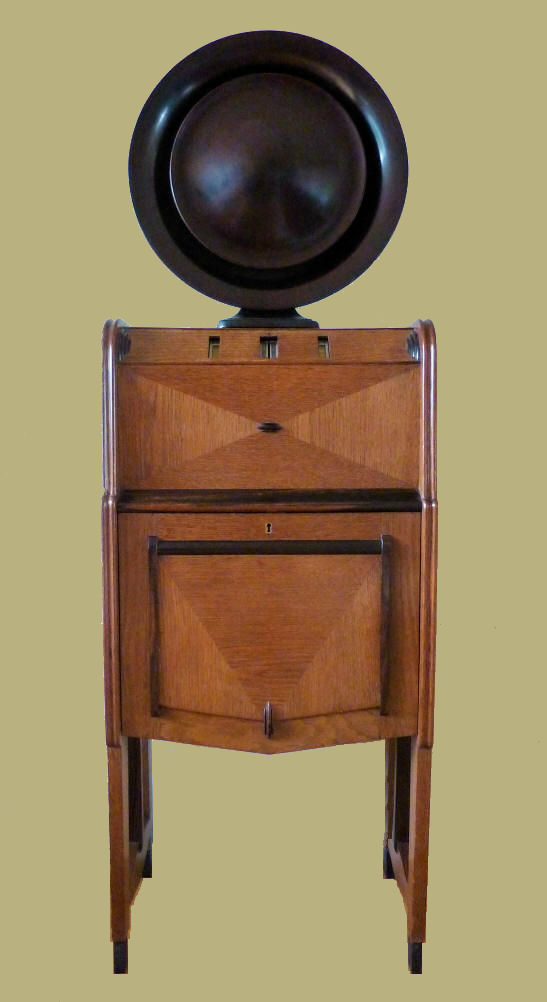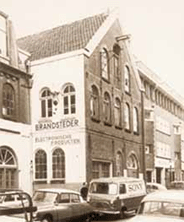|
|
|
 |
| |
 |
| Radio cabinet
for the Philips 2501/2502 radio |
|
Dutch Art Deco (Amsterdamse School) made around 1927 by A. Brandsteder, Amsterdam, for the Philips 2501/2502
radio. Material: oak wood and coromandel wood. |
|
The radio can be placed inside the top segment of
the cabinet. Three small rectangular openings make it possible
see both wave-length indicators and to operate the wave range
selector. In the lower half there is room for batteries or for
the Philips 372 power supply unit. Two small side doors are used
to reach the various knobs of the set. |
|
The same cabinet was also made
for the Philips 2514. |
|
I did not yet find information about the designer.
Some minor damage to the cabinet was fixed by furniture restorer Wiego Bergsma, Utrecht. |
|
A Brandsteder loudspeaker cabinet can be seen
here |
|
Measurements |
| Height: |
92 cm |
| Width: |
44 cm |
| Depth: |
28,5 cm |
| Sold in: 2023 |
|
 |
|
|
| The cabinet,
together with the Philips 2501 radio and the Philips
2003 loudspeaker, were
on display in the Van Abbemuseum in
Eindhoven from June 9th, 2012 until November 11th, 2012,
as part of an exhibition about the period 1924-1929. |
| |
 |
|
The Philips
2501, a Brandsteder radio cabinet and a Philips 2003
loudspeaker at the exhibition, June 15th, 2012 |
| |
|
|
.jpg) |
|
A. Brandsteder, Amsterdam brand. |
 |
|
Room for the Philips 372
battery eliminator (and an extra battery in case of a 2502
radio) behind the lid. |
.jpg) |
|
Radio cabinet
for the Philips 2514 or 2524 radio |
| The cabinet was
also made for the somewhat larger 2514/2524 radio. |
| Three ornaments in
coromandel wood were repaired by woodworker J.F. van
Zelst, Utrecht. |
| Measurements
|
| Height: |
92 cm |
| Width: |
49 cm |
| Depth: |
28,5 cm |
| Purchased in: |
2010 |
| Sold in: |
2023 |
|
 |
|
Radio cabinet |
|
Oak with coromandel details. The shape of the
sawn frame suggests that this cabinet was made for the
NSF 4
chassis. |
|
Measurements |
| Height: |
98,5 cm |
| Width: |
47 cm |
| Depth: |
36 cm |
| Made in in: |
±1926 |
| Purchased in: |
2011 |
| Sold in: |
2023 |
|
|
 |
History |
 |
On January 1st, 1924, Antonius Brandsteder,
(born in Amsterdam on September 17th 1889, he died in
Amsterdam on 19 September 19th, 1962), founded a small
workshop in Kerkstraat 121-123 in Amsterdam: "Brandsteder Spreekmachine Meubelen"
(picture left) The workshop made wooden cabinets for
gramophones (for example for Pathé),
radios and loudspeakers. Frame antennas were also made. A few years later the workshop
moved to 3e Schinkelstraat 33A (picture right).
|
 |
 |
|
After 1945, a sawmill in Bloemstraat 172
(picture left) made the panels for the cabinets; the cabinets were
assembled in the workshop in 3e Schinkelstraat. |
|
Brandsteder also imported the British Collaro
gramophones. |
|
In the early 1950s, Brandsteder started making
television cabinets. At that time the company employed
45 workers. |
|
In the late fifties, times were
getting harder and Brandsteder looked for additional
work. An English friend pointed his attention to Sony, a
brand that was not well known in Holland at that time.
Sony was looking for a distributor for its products. |
| In 1957,
son Anton Brandsteder, became managing director. |
|
Brandsteder stopped producing cabinets
and on the 6th of September 1965 it changed its
name to Brandsteder Electronics BV. The company moved
from 3e Schinkelstraat
33-33A to Parnassusweg 210 -214, also in Amsterdam (later
the company moved to Badhoevedorp).
In 1991 it became
Sony Netherlands (Since 1997 Sony Benelux). |
| |
|
 |
| Advertisement in Radio Expres, June
4th, 1926 |
 |
| Advertisement in KRO radio guide,
April 14th, 1928 |
|
|